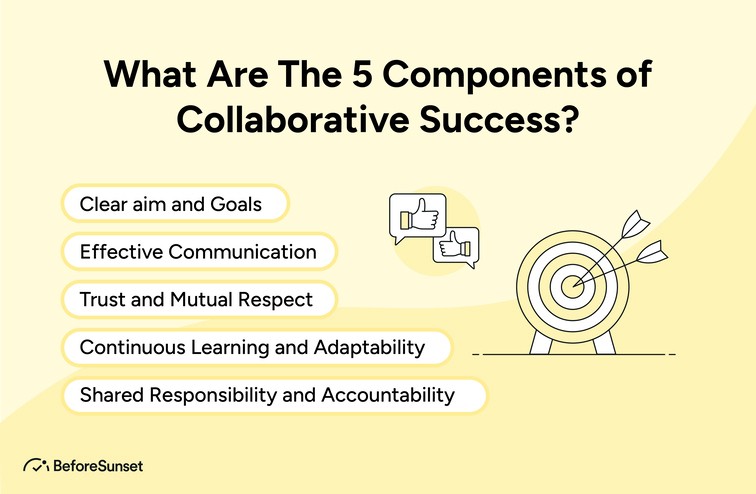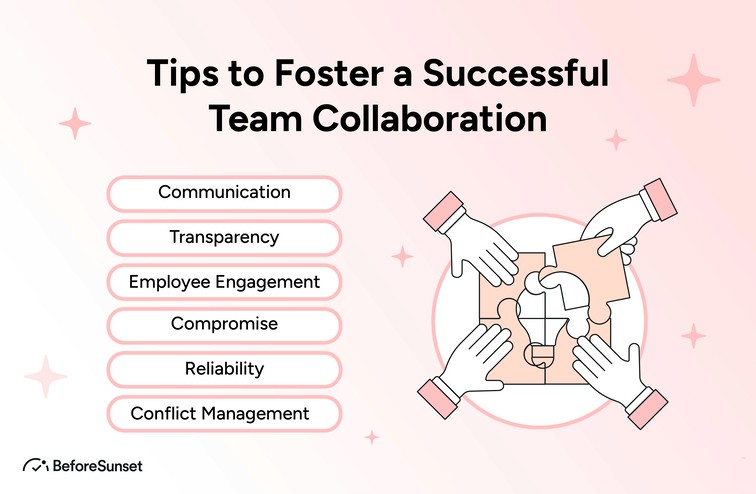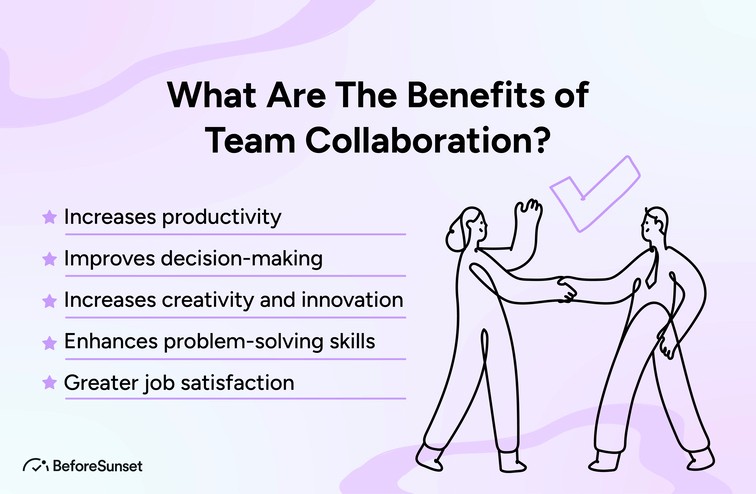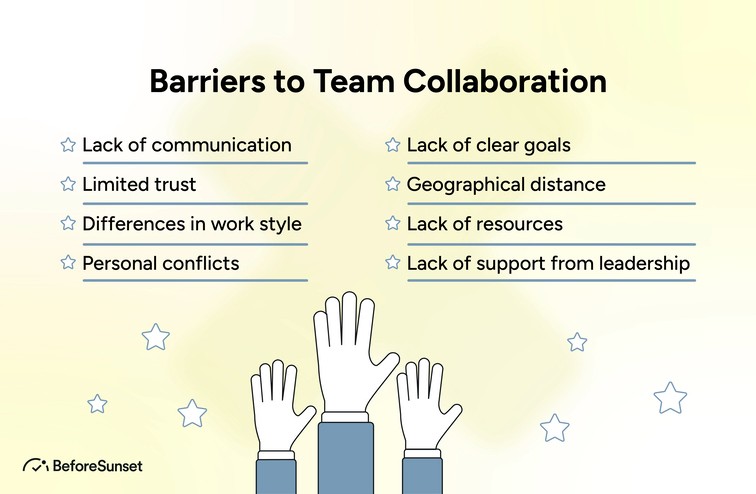Being able to work in a team is important for every workplace. The better the team has harmony the better the outcome and the productivity would get. The big question is how? To find out, keep reading!
Successful team collaboration is the key to thriving in today’s digital workplaces. It’s about more than working together—it’s building a collaborative environment where people pursue a common goal through clear communication, aligned objectives, and shared accountability.
Whether it's a marketing team brainstorming for a new product or virtual teams operating across time zones, effective collaboration strengthens employee retention, improves job satisfaction, and directly supports business goals.
You might also like:
Here’s a comprehensive guide on fostering collaboration, examining different types, tools, and benefits of collaboration.
Understanding Collaboration: Meaning and Types
The definition of collaboration revolves around coordinated efforts to achieve a shared outcome, but it comes in various forms.
Each type of collaboration is tailored to suit different organizational setups, from individual teams to cross-functional groups working on an intellectual endeavor. Here are some core collaboration styles:
Synchronous Collaboration: This involves real-time interaction, which can be particularly effective for team collaboration within virtual teams. Instant messaging platforms, video calls, and project management tools enable teams to collaborate regardless of location, making it ideal for fast-paced or deadline-driven tasks.
Cross-Functional Collaboration: With cross-functional collaboration, teams from different departments work together toward a common goal. For example, marketing teams can collaborate with product designers, creating a more diverse pool of ideas and perspectives. This form of collaboration brings fresh insights and helps teams accomplish goals that benefit the entire organization.
Chain Collaboration: This method involves a series of handoffs from one person or team to another, common in industries requiring strict workflows or structured project phases. Chain collaboration can be seen as a breakdown structure, where each contributor plays a specific role, ensuring efficiency and continuity.
Social and Contextual Collaboration: Social or contextual collaboration fosters relationship-building within teams, often through collaboration platforms that support team interaction beyond work tasks. This collaboration meaning extends to creating personal connections that enhance employee satisfaction and motivation.

What Are The 5 Components of Collaborative Success?
The following five elements combine to make a successful joint effort:
Clear aim and Goals: The effectiveness of collaboration depends on having a common understanding of its aim and objectives.
Effective Communication: The basis of successful collaboration is honest and efficient communication. Team members must actively listen, communicate their views effectively, and offer constructive criticism.
Trust and Mutual Respect: Mutual respect and trust are crucial elements of a successful joint effort. Each team member should have faith in the skills, goals, and commitments of the others.
Shared Responsibility and Accountability: Shared responsibility and accountability are essential for collaborative success. Each member of the team has to be aware of their duties within the partnership.
Continuous Learning and Adaptability: Successful cooperation necessitates a dedication to ongoing learning and flexibility. Teams should be receptive to fresh viewpoints and methodologies.

Benefits of Effective Team Collaboration
The benefits of collaboration go beyond task completion, impacting the quality of life at work, engagement, and innovation. Here’s why collaboration is essential for fostering a positive work culture and achieving organizational goals.
Boosts Job and Employee Satisfaction: Teamwork is linked to employee satisfaction, as working toward shared goals brings a sense of purpose and belonging. Organizations that value collaboration success experience higher levels of employee retention because team members feel appreciated and understood.
Achieving Business and Common Goals: When teams align on a common goal, their collective efforts drive more substantial results. Effective team collaboration promotes accountability and transparency, ensuring that each member understands their role in achieving business goals.
Encourages Idea Management and Innovation: Collaboration fosters a setting where new ideas thrive. When diverse perspectives converge, whether through social collaboration or intellectual endeavors, organizations benefit from idea management. This approach boosts creativity in fields like artistic collaboration and collaboration in music or other innovative industries.

Practical Steps to Foster Effective Team Collaboration
Building a successful collaboration culture requires an intentional approach, clear communication, and tools that facilitate seamless interaction. Here are practical steps to nurture collaboration skills and achieve collaboration success.
Set Clear Shared Goals and Structure
Begin by establishing shared goals that align with organizational objectives. A structured breakdown structure or roadmap clarifies each team member's role and milestones. This clarity is particularly useful for cross-functional and chain collaboration, where each department’s contribution plays a crucial role in the final product of collaboration.
Leverage Collaboration Platforms and Digital Tools
Tools such as instant messaging apps, collaboration devices, and project management software support efficient virtual collaboration and contextual collaboration. Whether for an individual team or a large organization, digital tools help bridge communication gaps, keep projects organized, and foster a collaborative environment.
Promote Effective Communication and Reduce Burnout
Healthy communication is foundational to collaboration success. By encouraging open dialogue and methods of communication tailored to the team’s needs, organizations create a sense of trust and understanding. It's also essential to prevent collaboration burnout by setting reasonable expectations and encouraging mindfulness exercises to manage stress in intense collaboration settings.
Examples of Collaboration in Action
Collaboration thrives in various sectors, from creative projects to healthcare, showcasing diverse forms of teamwork and approaches to collaboration. Here are a few examples of collaboration that highlight its versatility:
Many community-driven initiatives in American communities are products of inter-organizational collaboration, where multiple groups work together toward a unified cause, such as education reform or environmental conservation. This approach to collaboration combines resources and expertise for larger-scale impact.
In healthcare, collaboration in health care ensures patients receive comprehensive care from various specialists. From doctors to mental health professionals, collaboration between people in different fields allows for an integrated treatment approach that significantly benefits patients.
Artistic collaboration and collaboration in music allow creators from different backgrounds to blend their unique talents. A collaboration album by artists from various genres is a great example of this, resulting in innovative soundscapes that resonate with diverse audiences.
Key Factors for Collaboration Success
Strong collaboration skills—such as active listening, adaptability, and empathy—are crucial for thriving in any collaborative environment. These skills promote collaboration meaning in ways that enhance productivity and group dynamics, ensuring that team members contribute effectively toward shared goals.
Establishing a collaboration culture fosters unity and inclusivity. Organizations can build this culture by encouraging teamwork activities, celebrating collaboration success, and emphasizing the importance of collaboration skills across all departments.
Recognizing and supporting different types of collaboration within an organization, from cross-functional to structured collaboration, helps teams select the best method for each project. By integrating collaboration devices and offering training on collaboration best practices, companies can ensure a flexible, inclusive approach that meets each team’s needs.
How BeforeSunset AI Enhances Collaboration
BeforeSunset AI offers unique tools for teams to improve effective collaboration by supporting both individual team efforts and larger cross-functional collaboration. It creates a collaborative environment where every member can stay organized, track task progress, and communicate seamlessly, making it an ideal solution for teams aiming for successful collaboration in today’s digital workplaces.
Streamlined Task Management and Shared Goals
BeforeSunset AI promotes a common goal by simplifying task organization and tracking within a centralized platform. Teams can manage everyday tasks and complex projects with ease, allowing all members to stay informed on project progress and ensuring everyone works toward shared goals.
Real-Time Communication and Flexibility
With real-time updates and notifications, BeforeSunset AI helps reduce collaboration burnout by keeping communication concise and relevant. It’s designed for virtual collaboration, offering a variety of methods of communication—from integrated instant messaging to task comments—helping teams work effectively across locations and time zones.
Integration with Collaboration Tools for Enhanced Efficiency
BeforeSunset AI integrates with other collaboration platforms and collaboration devices, enabling seamless interaction with popular productivity tools. By doing so, it supports chain collaboration and structured collaboration, especially beneficial for virtual teams that rely on streamlined workflows and easy-to-access project information.
By combining task management, real-time updates, and robust integrations, BeforeSunset AI stands out as a powerful tool that elevates team collaboration. It not only makes collaboration success attainable but also creates a collaboration culture that boosts employee satisfaction and helps organizations achieve their business goals through a streamlined, intuitive interface.
Avoiding Collaboration Burnout and Ensuring Longevity
Collaboration can be incredibly productive, but there’s a risk of collaboration burnout if not managed properly. Here are tips to sustain effective teamwork without overwhelming employees:
Encourage Breaks and Time Off: Allowing team members to step back and recharge can prevent burnout. Encouraging regular breaks and ensuring no one is overburdened with responsibilities can maintain motivation and focus.
Use Technology to Streamline Collaboration: Technology can simplify repetitive tasks and free up time for more meaningful work. Implementing collaboration platforms and automation tools reduces the need for constant communication and keeps team members on track.
Set Realistic Expectations: Defining project goals and timelines clearly prevents misunderstandings and helps everyone manage their workload. Establishing achievable milestones and avoiding rushed deadlines ensures sustained engagement and collaboration quality.
Building a Collaborative Culture for Team Success
Creating a collaborative culture aligns common goals and encourages innovative ideas within teams. Here are some effective ways to build such a culture:
Define team goals that support the organization’s company culture. When everyone is aligned, it brings focus to each project, ensuring contributions are meaningful.
Real-time communication helps hybrid teams and remote employees stay updated, connected, and clear on tasks. Utilize collaboration tools to streamline updates and enable open dialogue across teams.
Practice active listening to ensure everyone’s ideas are valued. Constructive feedback fosters trust, allowing team members to build on each other’s strengths and create innovative solutions together.
Team leaders should model collaborative behaviors, and project managers can reinforce a supportive environment by recognizing each member’s skills and contributions, helping teams reach shared goals more effectively.
This approach builds a strong collaborative culture that boosts engagement and productivity across diverse skill sets.

Conclusion: Why Collaboration Matters
Successful team collaboration, defined by shared goals, effective communication, and well-planned methods of communication, strengthens both individual and team success.
Collaboration platforms make it possible to foster effective collaboration across various types of collaboration, from structured to virtual collaboration, allowing teams to adapt to changing demands.
Organizations that prioritize collaboration skills, encourage a collaboration culture, and carefully select the right collaboration platforms can significantly improve both employee satisfaction and job satisfaction. Embracing collaboration success means enhancing the quality of life for employees, reaching business goals more effectively, and creating a work environment where every team member’s contribution is valued.


